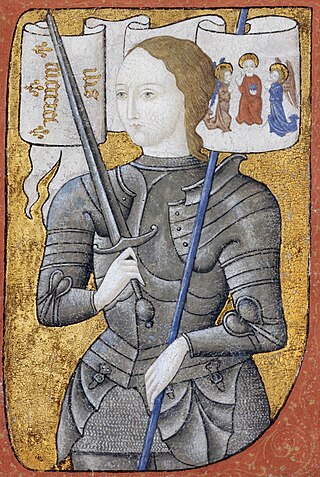
Joan of Arc is a patron saint of France, honored as a defender of the French nation for her role in the siege of Orléans and her insistence on the coronation of Charles VII of France during the Hundred Years' War. Stating that she was acting under divine guidance, she became a military leader who transcended gender roles and gained recognition as a savior of France.

The siege of Orléans was the watershed of the Hundred Years' War between France and England. The siege took place at the pinnacle of English power during the later stages of the war. The city held strategic and symbolic significance to both sides of the conflict. The consensus among contemporaries was that the English regent, John of Lancaster, would have succeeded in realizing his brother the English king Henry V's dream of conquering all of France if Orléans fell. For half a year the English and their French allies appeared to be winning, but the siege collapsed nine days after the arrival of Joan of Arc.
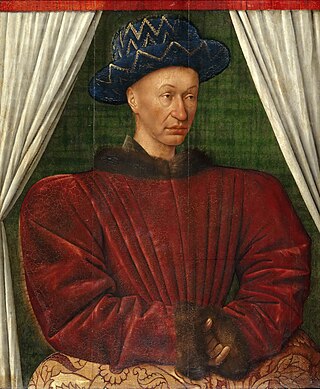
Charles VII, called the Victorious or the Well-Served, was King of France from 1422 to his death in 1461.
Duke of Berry or Duchess of Berry was a title in the Peerage of France. The Duchy of Berry, centred on Bourges, was originally created as an appanage for junior members of the French royal family and was frequently granted to female royals. The style Duke of Berry was later granted by several Bourbon monarchs to their grandsons. The last official Duke of Berry was Charles Ferdinand of Artois, son of Charles X. The title Duke of Berry is currently used as a courtesy title by Prince Alphonse de Bourbon, son of the Legitimist Pretender to the French Throne Louis Alphonse de Bourbon.
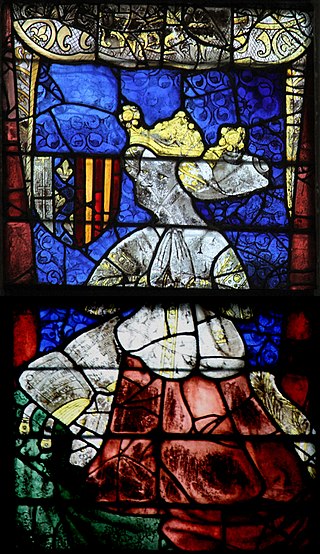
Yolande of Aragon was Duchess of Anjou and Countess of Provence by marriage, who acted as regent of Provence during the minority of her son. She was a daughter of John I of Aragon and his wife Violant of Bar. Yolande played a crucial role in the struggles between France and England, influencing events such as the financing of Joan of Arc's army in 1429 that helped tip the balance in favour of the French. She was also known as Yolanda de Aragón and Violant d'Aragó. Tradition holds that she commissioned the famous Rohan Hours.
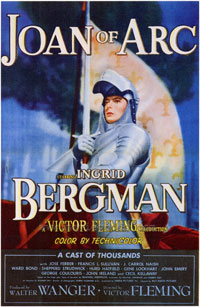
Joan of Arc is a 1948 American hagiographic epic film directed by Victor Fleming, and starring Ingrid Bergman as the eponymous French religious icon and war heroine. It was produced by Walter Wanger and is based on Maxwell Anderson's successful Broadway play Joan of Lorraine, which also starred Bergman, and was adapted for the screen by Anderson himself, in collaboration with Andrew Solt. It is the only film of an Anderson play for which the author wrote the film script. It is the last film Fleming directed before his death in 1949.
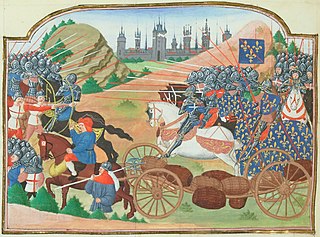
The Battle of the Herrings, also called the Battle of Rouvray, was a military action near the town of Rouvray in France, just north of Orléans, which took place on 12 February 1429, during the siege of Orléans in the Hundred Years' War. The immediate cause of the battle was an attempt by French and Scottish forces, led by Charles of Bourbon and Sir John Stewart of Darnley, to intercept a supply convoy headed for the English army at Orléans. The English had been laying siege to the city since the previous October. This supply convoy was escorted by an English force under Sir John Fastolf and had been outfitted in Paris, from whence it had departed some time earlier. The battle was decisively won by the English.

Saint Joan is a 1957 historical drama film adapted from the 1923 George Bernard Shaw play of the same title about the life of Joan of Arc. The restructured screenplay by Graham Greene, directed by Otto Preminger, begins with the play's last scene, which then becomes the springboard for a long flashback, from which the main story is told. At the end of the flashback, the film then returns to the play's final scene, which then continues through to the end.
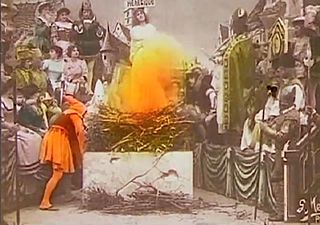
Joan of Arc is a 1900 French silent film directed by Georges Méliès, based on the life of Joan of Arc.

Baudricourt is a commune in the Vosges department in Grand Est in northeastern France.

Joan of Arc is a 1999 Canadian two-part television miniseries about the 15th-century Catholic saint of the same name. The miniseries stars Leelee Sobieski as Saint Joan. A joint production of the Canadian Broadcasting Corporation and Alliance Atlantis Communications, it was shown internationally in 1999.

Joan of Arc was a young French woman who said she had been sent to help Charles VII during the Hundred Years' War, which led to her capture by the English-allied Burgundians during the siege of Compiègne in 1430. She was sold to the English, who had her put on trial by a pro-English church court at Rouen, Normandy in 1431. The court found her guilty of heresy and she was burned at the stake. The verdict was later nullified at Joan's rehabilitation trial, which was overseen by the Inquisitor-General, Jean Bréhal, in 1456. Considered a French national heroine, she was declared a saint by the Roman Catholic Church in 1920. The trial is one of the most famous in history, becoming the subject of many books and films.

The Scottish Guards was a bodyguard unit founded in 1418 by the Valois Charles VII of France, to be personal bodyguards to the French monarchy. They were assimilated into the Maison du Roi and later formed the first company of the Garde du Corps du Roi.

Jean d'Aulon (1390–1458) was a French knight and lord best known for serving alongside Jeanne d'Arc as her soldier, steward, bodyguard, and squire. Some sources incorrectly attribute the role of d'Arc's bodyguard to Gilles de Rais. d'Aulon was an avid and detailed journaler and his records, considered to be honest and straightforward, set the foundation for what we know about Jeanne d'Arc, including her apparent amenorrhea.
Jean de Metz was a French nobleman who is known primarily for his role in the exploits of Joan of Arc.
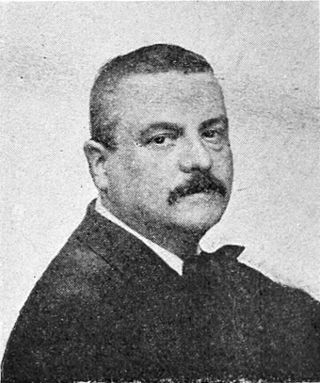
Lionel-Noël Royer was a French painter. He was most famous for painting large scenes of the life of Joan of Arc in the Basilica of Bois-Chenu in Domrémy.
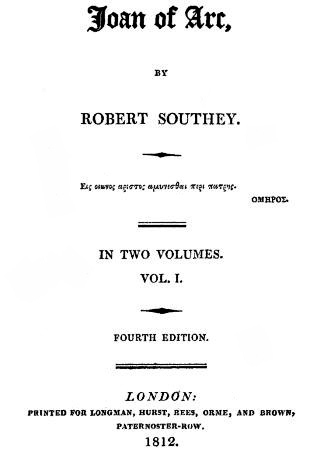
Joan of Arc is a 1796 epic poem composed by Robert Southey. The idea for the story came from a discussion between Southey and Grosvenor Bedford, when Southey realised that the story would be suitable for an epic. The subject further appealed to Southey because the events of the French Revolution were concurrent to the writing of the poem and would serve as a parallel to current events. Eventually, Samuel Taylor Coleridge helped rewrite parts of the poem for a 1798 edition. Later editions removed Coleridge's additions along with other changes.
Bertrand de Poulengy was a French nobleman who is best known for his association with Joan of Arc during the Hundred Years' War.

After the French lifted the siege of Orléans and won a decisive victory at the Battle of Patay, the English and Burgundians no longer posed a threat. Joan of Arc convinced the Dauphin Charles to go to Reims for his coronation. Successfully marching their army though the heart of territory held by the hostile Burgundians solidified the Dauphin’s grasp on the throne of France. He had been disinherited from it through the Treaty of Troyes.
Jean de Baudricourt was a French Grand Officer Royal and a marshal of France born in 1435 CE. He was the son of Robert de Baudricourt and Arlearde de Chambley. He died in Blois on 11 May 1499.















